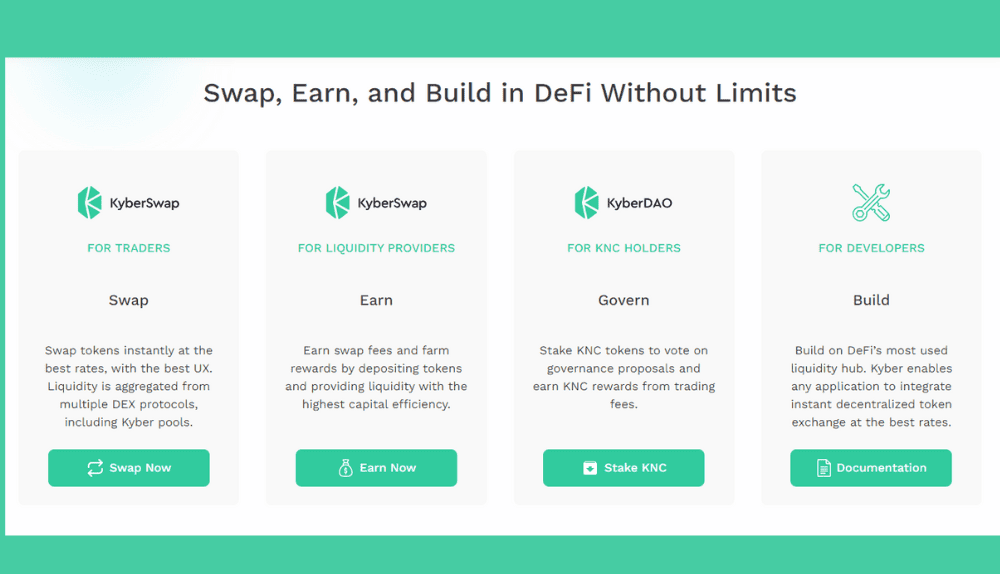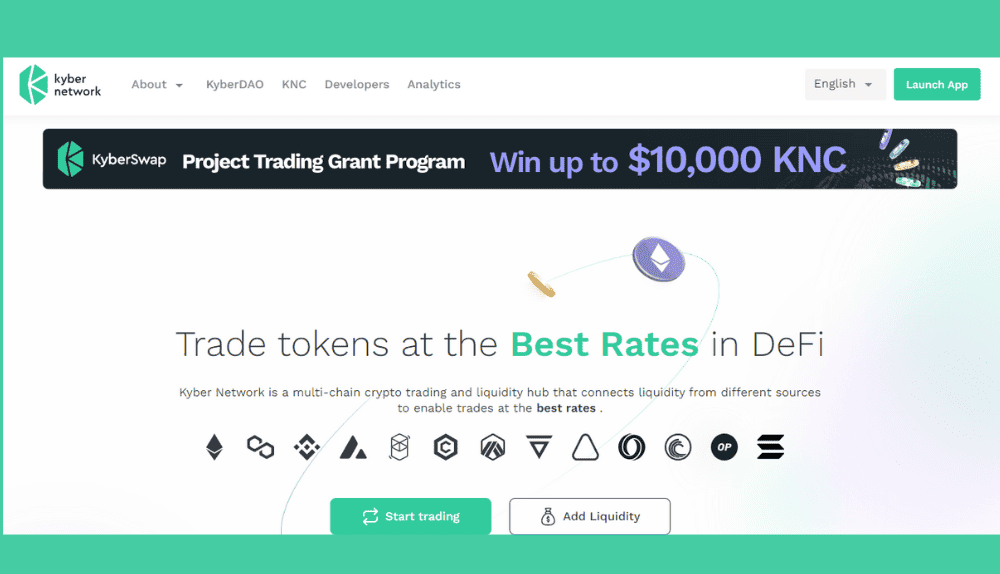What is Kyber Network Crystal (KNC)?
Key Takeaways: –
- Kyber Network Crystal is a decentralized exchange (DEX) that solves the problem of liquidity in the DeFi space.
- Kyber Network achieves this by aggregating liquidity from multiple DEXes and providing users with the best possible rates for their trades.
- Kyber Network also offers a range of other features, such as a decentralized autonomous organization (DAO) that allows users to participate in the governance of the network, and a staking program that rewards users for holding KNC tokens.
Lack of liquidity is a common problem that most user experience in the DeFi space. Even developers struggle to provide a range of features due to this problem. Most decentralized exchanges work independently which they can’t maintain the proper amount of funds in different pools.
Although decentralized exchanges are offering different incentives to bring more liquidity to the platform, they struggle to meet the users’ requirements as the platform grows. It shows that the industry is in need of a platform that can solve this problem without engaging a third-party service.
Kyber Network is dedicated to solving this problem in an innovative manner.
What is Kyber Network Crystal?
Kyber Network combines multiple decentralized exchanges to address liquidity problems. The users don’t need to go through the registration process and they can exchange different assets instantly. Kyber Network is primarily focused on providing access to deep liquidity pools. Thus, different DeFi platforms can offer the best possible rates to customers.

The most important use case of this protocol is that the application hosts can allow customers to pay for the services with a wide range of tokens. However, the host will receive the payment in their desired tokens. So, if the host has selected Ethereum as their preferred currency, they will receive the payment in Ethereum no matter which crypto token the customer has used to pay for the service.
The platform performs the conversion in the background and the final amount is transferred to the service provider. Thus, the users can also access multiple features of a wide range of applications even if they aren’t token holders of that particular DApp. With Kyber, the users can instantly swap their existing tokens for DApp-specific tokens and use the services they want.
The platform ensures the transparency of the transactions by directly updating the information on Ethereum.
KyberSwap
KyberSwap is the leading aggregator of the Kyber Network that offers the most attractive swap rates for traders compared to the individually operating exchanges. The aggregator sources liquidity from multiple DEXes including PancakeSwap, Uniswap, SpiritSwap, Sushi Swap, VVS Finance, Pangolin, GMX, Curve, Spookyswap, Velodrome, Traderjoe, and more.

Thus, it provides additional earning opportunities for liquidity providers. Moreover, the traders also get to access the most favorable rates with these aggregated liquidity sources. Currently, the platform provides support for 13 chains including Ethereum, Avalanche, Optimism, BNB Chain, BitTorrent, Velas, Arbitrum, Polygon, Cronos, Ethereum PoW, Aurora, Fantom, and Oasis Network.
The team is also working on adding Solana along with a few other chains. The interesting thing about KyberSwap is that users can access its features without having to sign up or register for the platform.
The developers no longer need to worry about the lack of liquidity as the platform solves this problem with a range of features like liquidity aggregation for optimal rates, a customizable business model, instant settlement of token swaps, and multiple liquidity pools.
KNC DAO
Like traditional DEXes, Kyber Network has also integrated a decentralized autonomous organization that determines different aspects of the protocol. The users can become a member of this organization by staking their KNC tokens. They can then vote on several proposals and participate in the platform’s governance.
The platform offers staking rewards to these users for their contribution. The rewards are derived from the trading fees that the traders need to pay while requesting a transaction.
Kyber Network Brief History
Kyber Network was introduced by Loi Luu (CEO), Victor Tran (CTO), and Yaron Velner (official advisor) in 2017. Kyber team sold around 226 million KNC tokens during an initial coin offering in September 2017. Thus, they raised around $52 million worth of ETH tokens (around 200,000 ETH).
Signum Capital, Hyperchain Capital, ParaFi Capital, and #Hashed are the leading names that invested in this project. In October 2017, the total supply was brought down to 215 million by burning 10 million KNC tokens in circulation. The mainnet was officially launched in February 2018.
In 2021, the network introduced its own decentralized exchange aggregator, KyberSwap, which supports the swapping of crypto tokens across multiple exchanges. The aggregator has successfully processed more than 5 billion transactions since its launch. In 2022, Kyber Network partnered with multiple leading projects including Ethereum, Polygon, and Binance Smart Chain.
According to a recent update, the Kyber network has more than 100,000 active users and the number is rapidly growing.
How Does Kyber Network Work?
Kyber Network provides an exchange service with three main components:
- Reserves – Reserves are like liquidity pools that provide liquidity to the platform.
- Smart Contracts – Used to trade and exchange different assets on the network.
- Takers – Regular traders, vendors, and DApps that take liquidity from the platform.
Kyber Reserve Model
As discussed earlier, Kyber Network uses Reserves instead of liquidity pools. Thus, the platform provides the best available rates by going through the reserves when a user requests a transaction. Kyber Network instantly converts the tokens with its three main reserves.
Price Feed Reserves – It calculates the conversion rates using price feeds and consistently updates data on smart contracts. The Takers can calculate token conversion rates using smart contracts.
Automated Price Reserves – It updates the rates for available tokens with the help of smart contracts. The smart contracts are designed to store the tokens so they may be used for swapping whenever needed.
Bridge Reserves – As the name suggests, these reserves are connecting to other exchanges. They enable users to purchase tokens from other decentralized exchanges at the best possible rates.
Kyber Network Tokenomics
KNC is the native token of Kyber Network that is used to pay transaction fees while swapping tokens. The token holders can stake their KNC tokens to participate in the network’s governance. With a circulating supply of 181.4 million tokens, KNC has a market cap of $89 million.
It ranks among the 200 best cryptocurrencies in terms of market cap. It has a total supply of 252 million tokens that will be released through the rewarding process over time.
Conclusion
Kyber Network is a decentralized exchange that solves the problem of liquidity in the DeFi space. It aggregates liquidity from multiple DEXes to provide users with the best possible rates for their trades. Kyber Network is a promising project with the potential to revolutionize the way that people trade cryptocurrencies.
Feel free to get in touch with us if you need more information about how Kyber Network Crystal work. We also invite you to subscribe to our weekly newsletter if you need regular updates about Bitcoin and the crypto market.











